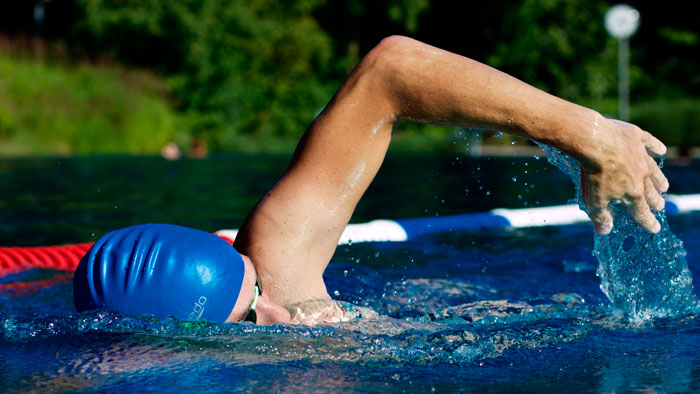
A few months ago, I had a BIG problem.
Hands tired. Backaches. Migraines. The works.
What was going on? I needed to get some help….
So, I detailed my troubles in an email I sent out to my readers a few months ago:
“What I’ve been worried about: I’ve been seriously clocking up the hours doing some intense jazz guitar practice and study lately. Coupled with time spent at the computer doing website maintenance etc. means I’ve been spending long hours sitting in my studio and my back is starting to give me grief. I’ve been reading about the dangers of excessive sitting, which has really got me thinking about how to have a more healthy approach to work.
Do you have any ideas for keeping your body in tip-top shape when needing to practice for long hours? I would love to get your thoughts!”
The response to this email was overwhelming.
Many guitarists from around the world replied and gave me loads of helpful ideas to relieve tension and pain for both inside and outside the practice room.
I benefitted so much from their suggestions that I thought it would be helpful to share the responses with you.
(Disclaimer: I am not a medical doctor or healthcare practitioner, and any of the comments expressed by myself or the contributors in this article are merely opinions of the authors, and do not constitute medical advice.)
Ken Niehoff
“Hi Greg, thanks for your teaching. I’m a health trainer and use my knowledge of exercise, nutrition and psychology to help individuals achieve a healthier lifestyle.
I only practice guitar standing up or leaning on something high. I use my computer and read on my iPad standing up. You just have to get used to it and you will. Standing with my electric guitar for practice did cause a problem that I solved. Holding a heavy guitar is a pain and mine is just over 6 lbs. I practice all my jazz on a short scale (23in) classical guitar with a cutaway that weighs 3 lbs.
When I have to work up something for performance (not lately) I make sure to switch to the performance guitar. This choice is easy on my hands and shoulders.
Walking around the block between bouts of heavy concentration is a good idea and I recommend keeping it up. For better fitness and using less time I recommend doing something that completely gets you out of breath: fast squats to exhaustion or fast stair walk or run. If you live on a hillside, fast walk or run up the hill. You could add a set of push-ups or some other weight exercise once in a while. Use your imagination for ways to get out of breath. Come back and hit your studies. I recommend doing this one time per hour but you will still need to stop sitting so much. You can get out of breath out in as little as one minute.
Take care, Ken”
~ Ken Niehoff MS
I took on Ken’s suggestions and ended up using my Yamaha Silent guitar as my main instrument for practice. This guitar is incredibly lightweight due to having no body, which really eased up the strain on my back whilst standing with a strap. I’m also doing the brisk walk up my local hill daily as Ken suggested.

Rusty Smith
“Thanks for reminders about how to practice. I am almost 70 and need to be careful in my practicing. There were times I would practice 6-8 hours in a day but only one day a week. The other days were an hour or two. The routine that worked for me was to never practice more than 45-50 minutes. Then get up and take a 10-minute break. Didn’t matter if I was in the middle to something I thought I should complete. Seemed to refresh me in a way that allowed many hours of practice and I also became more productive. ~ Rusty”
Following Rusty’s advice, I looked into ways to manage time and came across the Pomodoro technique which is an excellent way to manage time and encourage breaks – find out more about it here.
Ben
“Hi Greg,
Back problems – I have a lot of experience in this department. In the past, I have had regular bouts of backache, to the point where I would expect it every 2 weeks or so.
I’m actually a drummer/percussionist, and moving gear, driving to gigs, sitting for hours at a kit, standing with a foot on the vibes pedal etc. all has resulted in back problems over the years.
I have previously used chiropractic for when I have a really bad knot in my back, but though it gave some immediate relief, it wasn’t really treating the underlying problem. I actually wouldn’t recommend chiropractic as it’s expensive and in my experience, it doesn’t work long term.
I have found the best relief for immediate back pain is Ibuprofen (an anti-inflammatory over the counter drug in the UK) and putting a ‘Theraflex’ ice-pack wrapped in a tea-towel under my back and lying down for about ten minutes at a time.
I have also more recently started Pilates which seems to be helping for inner core strength, as does swimming. But, the best help I have had is from my fiancee who is a therapist, who has observed me moving and suggested ALWAYS bending from the knees when bending down. Before I would just lean over to pick something up, now I don’t, and it has really helped me keep my back from going into spasm.
So, in brief: improving core strength, swimming (good all round support), avoiding sitting awkwardly or for long periods and good moving and handling all helps. As does a good mattress!
Now it is extremely rare that I get back ache, and when I do, it is less severe, and lasts for far less time.
Hope that helps!
Best wishes,
Ben”

Peter King
“Greg,
I have encountered similar challenges of prolonged sitting (not just playing guitar but my day job) and started having back aches and gluteal pain. The important concept to grasp is that the problems need to be proactively addressed since flexibility and tolerance for mechanical strain lessens with the aging factor. I am in the medical field and my wife is a physical therapist both of which have given me more insight into the problems. What is absolutely essential is to maintain core muscles that support the spine (back muscles and abdominal muscles). They will weaken with prolonged disuse and could lead to more serious problems including herniated discs and degenerative disease. Here is what I have done that has markedly improved things:
1) Using a strap is essential (I am mainly a classical guitarist and the left foot on a stool was killing me!). I can now play with both feet even. I even play the classical guitar standing and occasionally walk around and play.
2) Strengthen core muscles: swimming is the absolute best way to do this. I swim 3 days a week. Regular walking (4-5 miles) is another way.
3) Light weight lifting focusing on axial muscles
4) Stretching. This should include gluteal muscles, quads and hamstrings—because they all feed into the core muscles.
5) Regular breaks while playing—every ½ hour get up and walk around etc.
6) Stand up desk. I got mine from varidesk.com. This is an adjustable desk that sits on top of a regular desk. You can raise it to multiple different levels depending on your comfort zone. You can collapse the desk at any time and use it as a regular desk (takes less than 5 seconds)
7) See a physical therapist to get more formalized exercise/stretching approaches. One or two visits should suffice.
8) Be religious about doing all of the above. One or two times a week will do no good. do something every day.
Best,
Peter King”
After reading Peter’s email, I took the plunge and purchased a standing desk – this has been a real game changer for back pain.
Mark Jobin
“As a computer technician I spent most of my time sitting and started to develop some lower back pain. I started practicing yoga again after a break of some 30 years and I found it made a real difference. I do about 3/4 of an hour 3 times a week – mostly stretches, not the pretzel-like postures. ~ Mark”

Last But Not Least, ‘D.D’…
“Dear Greg,
As I have grown older my back has started hurting due to the sitting position with left leg raised while holding my classical guitar. I practice about 2 hours each day. Believe me, the best thing you can do is to take a good walk between your sessions or after them. After my practice sessions, I take a brisk 2 km walk. I do this every day, even if it is raining, snowing, hot as hell, etc. I am in my 70’s and not only does it relieve my back pain, it is good cardiovascular exercise as well.
Now that I am studying jazz, I often will stand and wear a strap around my Fender stratocaster. I chose the strat because I love playing blues as well as jazz. You look to be in good shape – so take it from an old guy, don’t forget to exercise. I know how busy you must be developing these lessons for us and I greatly appreciate them.
And one final thing: DO NOT RUN. It is bad for your knees particularly if you run on asphalt. Walking, on the other hand, is much easier on the knees and back. Less impact stress on the spine. Swimming is also a good option if you can get access to a pool.
Besides walking, I do a number of yoga exercises for my back after a practice session. One is to get on the floor and bring my legs up to my chest and hold them for a few seconds and then release the legs back to the floor. There a number of websites where you can find yoga exercises for lower back pain and spine. I do a number of the poses found on the website: http://www.thefitindian.com/10-best-yoga-poses-to-relieve-lower-back-pain/
Keep up the good work and thanks again for everything you have done to help me and others learn the elements of jazz.~ D.D”
Thanks to D.D’s suggestions, I’ve prioritized a short yoga routine in my daily regime, and I’ve been getting fabulous results. I also practice meditation daily as well.
Discussion
I hope this post helped give you ideas on how to make your practice room a healthier and happier one. A huge thanks to all the contributors who gave their permission to publish their tips.
It’s important to take your physical health seriously if you’re practicing many hours on an instrument.
Why?
It not only helps you to feel better but also enables you to focus more, which will help the music and ideas flow much more easily during a jazz guitar session.
Over to you – what other thoughts or suggestions would YOU like to contribute to this topic of ‘The Healthy Woodshed’? Leave a comment below with your thoughts…


I have found the following warm up exercises recommended by gypsy jazz guitarist Yaakov Hoter very helpful: https://www.youtube.com/watch?v=ToKjtQDwRY0
Some great tips in here, and very timely for me: I sit at a computer for 9 hours a day at my day job, then after work I begin working on my website (much like yourself)… so even more sitting at the computer. Eventually, I practice guitar, which is even more sitting. In the last couple years, my back has really begun to kill me–especially at night when trying to sleep. I’m also beginning to have pain in the back of one of my legs. I’m starting to do some of the things your readers have suggested here… such as standing while practicing guitar. I’m also looking into getting a sit/stand desk (for work) that’ll allow me to stand when I want to.
with advancing years I have found a stiffness, on waking, and for several years now I sit on the edge of the bed and do some stretching exercises.
with a bit of thought this can be developed further. what started as a bit of a stretch has advanced to about 10mins of exercise. I walk every day. have an excersize bike that gets the blood running.
Hi… I get upper back and shoulder ache after playing for long periods. Unfortunately for me, I developed the “bad” habit of sitting when I play and have a very difficult time trying to play standing. It is important to have a high enough stool to raise your leg and guitar to a comfortable height so not hunching over. Better to practice multiple times per day for short stints as opposed to long periods. This is also better for the hands and fingers. I am 73 and have arthritis in both wrists. I purchased a Zager guitar a few years ago. It is an acoustic/electric. They are known and advertise to be an “easy-play” guitar. I suggest anyone with hand/wrist/finger issues to check them out. Cheers!